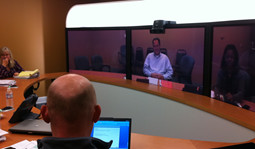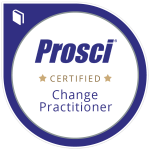“Companies are beginning to find that social technologies have enormous potential to raise the productivity of knowledge workers.”
McKinsey Global Institute*
The concept of vetting an idea has universal application in ideas large and small. The following case study is based on an executive’s need to move quickly to create and embed an operational strategy in her newly formed organization. We also worked with her to expand the engagement benefits to included establishing a beachhead of social business capability within the leadership of her organization.
The opportunity
The CFO for a then recent spin-out was transforming the inherited elements of her function to achieve the following strategic priorities
- High integration with business units and other functions
- Strong performance management
- Efficient, scalable growth platform
- Effective communication
- Customer service excellence
Leading Consulting (an alias) was hired to bring their best-practice suite of finance processes to jump-start the effort. Initially they focused on working with a few key executives. These select few included the CFO and a handful of sub-functional heads tapped for their special knowledge. Each of the few key executives where only exposed to the thinking in their area of expertise.
We helped the CFO improve business results while building social business capabilities in what we refer to as delivering on two fronts. We believe the effort in both areas (business and social) require rigorous change leadership including a number of Kotter’s change accelerators. For example:
- Communicating the change vision,
- Empowering broad-based action, and
- Short-term wins
Click here for our POV- a more comprehensive treatment of change leadership and Professor Kotter’s thinking.
Deliver on two fronts: Objectives
The primary objective of our work with clients has always been to focus on business outcomes. In some cases, as with this engagement, we are asked to focus on mission critical issues. When building social business capabilities, we begin with the business outcome and find relevant supporting social business elements to embed into the approach. The following highlight business and social capability objectives.
|
Business Outcomes |
Social Business Outcomes |
|
|
These objectives point to a critical success factor: Getting finance leadership up to the speed of transformation.
Approach overview, including social mechanics
 The financial leadership team (about 30 key executives and managers) organized around the work to be accomplished: four overlapping teams each focused on a grouping of recommendations clustered around their sub-function specialty (e.g., accounting, tax…). Each of the four teams was asked to deliver their recommendations in a common template addressing the following
The financial leadership team (about 30 key executives and managers) organized around the work to be accomplished: four overlapping teams each focused on a grouping of recommendations clustered around their sub-function specialty (e.g., accounting, tax…). Each of the four teams was asked to deliver their recommendations in a common template addressing the following
- Change readiness
- Risks, concerns and barriers
- Possible information gaps
- Overall recommendations and priorities
We designed two of our hard-learned lessons for rolling out social business capabilities into this social vetting effort: 1) build the new way into the approach and 2) blend traditional, proven methods with emerging collaborative approaches.
Key social business elements of the approach included
- Seamless approach- vetting was designed into the overall transformation roadmap (required the tight three-week window)
- Use of an enabling collaborative platform (SharePoint 2010, out of the box) including four vetting group support sites
- Light moderation and content curation
- Initial training of the leadership team in both the approach and use of the enabling platform
- Virtual kickoff, two break out team meetings (combination of virtual and co-located) and an all-team final review meeting at the corporate headquarters
- Visibility of all work to all participants, including the CFO
Deliver on two fronts: Results
The sponsor said…
The three week effort satisfied the CFO/sponsor as she shared with the finance division- “we have revised initiative priorities and restructured the implementation roadmap”. Regarding the effectiveness of social engagement objectives, the CFO/sponsor added in a report-out to the company’s leadership team at an offsite a few weeks after the effort- “my employees, who didn’t even know me for the first 18 months of roadshows, now love me”.
Team executives and managers said…
Nearly half of the team participated in a post vetting process survey and expressed unanimous support for the approach and the final result.
A quick overview…
|
Business Outcomes/Transformation |
Social Capabilities/Transformation |
|
|
The two transformation efforts, functional (finance) recommendations and social business capabilities (anchoring social business engagement), became intertwined going forward with leadership leading the charge for change.
A couple of closing thoughts
We believe that successful adoption of social business is an iterative process, layering-in capabilities coupled to mission critical issues and directly linked to performance drivers. The pace of implementation must recognize and align with the organization’s change readiness. Every corporation is different, requiring a high degree of customization.
We believe there are many opportunities for introducing and applying social business capabilities within the enterprise. For example, in the referenced article McKinsey evaluate the relative benefit to enterprise functions (Click here to see an Enterprise Process Model). Further, possibly the most critical starting point is advocacy for and definition of what you believe social business to be (Click here to see see our 5i’s, a social business capability framework).
You can start to create social business capability. You can start now with your group. You can benefit almost immediately, just as our clients have.
“Organizations that fail to invest in understanding social technologies will be at greater risk of having their business models disrupted by social technologies”
McKinsey Global Institute*
* Excerpts from Michael Chui, et al, “The social economy: Unlocking value and productivity through social technologies” Executive Summary, McKinsey Global Institute, July 2012 [Internet] [Cited January 9, 2013]. Available from http://www.mckinsey.com/insights/mgi/research/technology_and_innovation/the_social_economy. This study also quantifies untapped potential of social business between 900 MM and 1.3 trillion USD annually in studied industries worldwide.







